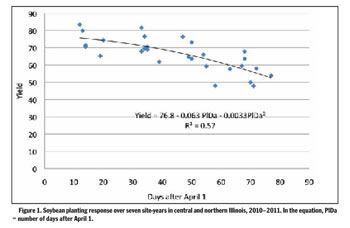Is It Time To Plant Soybeans?
URBANA, ILL.
Like corn, soybean planting has had an unusually early start in Illinois this year, with 1 percent of the crop planted by April 1 and 2 percent by April 8. As more producers finish planting corn in the coming days, attention will turn to the advisability of starting to plant soybeans in April.
Over the past two years we have conducted studies at six Illinois locations to look at the question of planting date. We acknowledge with gratitude funding for this work from the Illinois Soybean Association.
These trials did not produce very useful results at the two southern Illinois locations, mostly because wet springs delayed or destroyed the first plantings. We found little trend in yields with planting delays through early June, with losses accelerating after that. But there was so much variability over years and locations that we could not draw sound conclusions.
In contrast, responses to planting date were remarkably consistent among years and locations in central and northern Illinois. Across seven site-years, yields were highest at the earliest planting dates (mid-April), and they declined in an accelerating fashion after that (Figure 1). Using the equation generated from the data, we find that yield loss accelerates from 0.1 to 0.2 bushels per acre per day of delay in April, from 0.3 to 0.4 bushels per acre per day in May, and is at 0.5 bushels of yield loss per acre per day of delay in early June.
Such high yields from mid-April planting, and the early start to yield losses with planting delays, are not consistent with what we found in earlier research on soybean planting date. We, and researchers in other states, have generally found that soybeans suffer little yield loss from planting delays until after the middle of May, with relatively mild losses from planting in late May.
Why the difference these last two years? We do not believe that some sort of switch has been flipped, such that soybeans now act very differently than they did before. Unlike much of the work in the past, both 2010 and 2011 were favorable, with consistently high yields across all locations. This raises the interesting possibility that early planting helps yields only (or mostly) when conditions for high yields exist throughout the season. One problem with this theory is that at Perry in 2011, where it was dry and yields averaged only 32 bushels per acre, the response to planting date was almost identical to the response seen in Figure 1.
Regardless, there is now evidence that waiting until some date in May to plant soybeans may not improve yields. Finishing corn planting then starting in with soybean planting may be sound management, at least once we’re past mid-April. We have seen a few times in the past when planting very early – in early April – can have detrimental physiological effects, much like corn can when emerged and growing plants experience cold weather.

Figure 1. Soybean planting response over seven
site-years
in central and northern Illinois, 2010–2011. In the equation,
PlDa = number of days after April 1.
One caution that applies here is that surface soil moisture levels may be too low for soybeans to germinate in some areas. We have heard similar reports regarding corn planting, and some have been holding off on corn until rainfall moistens the surface. With neither crop is it a very good idea to try to “plant to moisture” this early, given that deep-planted seeds take longer to emerge and that emergence can be reduced substantially if we do get rainfall accompanied by lower temperatures.
Finally, uniformity of soil moisture at planting depth is not very good in many fields where it has rained little so far in April. Trying to improve uniformity of soil moisture at planting depth by tillage often does not work very well when moisture is in short supply. Planting into uneven moisture can result in uneven emergence and plant size, which can reduce yield.
In the case of soybean, enough water to start the germination process but inadequate water to get plants to emerge often results in death of the seed and seedling. Thus if soils are too dry to germinate soybeans, it may be preferable to wait until after it rains to plant. Because corn seed needs less water than soybean to germinate, and because corn emerges better than soybean in most cases, planting corn seed into dry soils is less risky. Δ
DR. EMERSON NAFZIGER: Professor Research Education Center Coordinator, University of Illinois